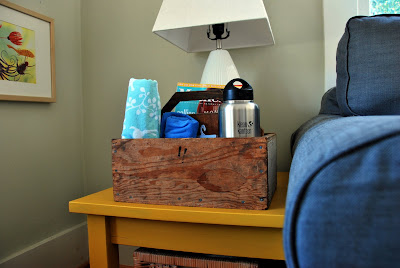When
Matt and I were planning
our wedding, I would go through phases of insecurity related to blogging about the experience and sharing it with others. I would write a post about how we were doing x, y, and z, and then I would stop and wonder, "But what if it totally fails? What if the event feels completely 'budget' and 'tacky' because we did x, y, and z? Maybe I shouldn't be putting any of these ideas out into the universe until I know they actually work?"
I think I've been feeling something similar about our home birth experience. I haven't talked much about it because if something goes terribly wrong and I wish I would have given birth in a hospital, I might feel terrible that I promoted home birth for the previous nine months.
However, Matt and I are having such a wonderful experience with our midwife, and with each passing day, we are more and more convinced that we chose the right path for our family. At this point--even if we do have some rare complication/emergency that can't be solved by our midwife or by a hospital transport and could only have been successfully dealt with if we had already been in the hospital--I still think I would be an advocate for home birth. That's why I feel like it's important to write this post (while the outcomes are still uncertain).
But let me back up and say that I am not proselytizing about home birth. I don't believe in a "one-size-fits-all" approach to birth. I think each of us needs to find the path that is right for us. I would never recommend a home birth to someone who isn't completely comfortable with the idea and who couldn't bring themselves to feel safe in that environment. It's important for all of us to feel safe and confident as we head into birth. Also, the kinds of care that are available to each of us varies so much from city to city and town to town.
The only thing I am dogmatic about related to this issue is that we should each find caregivers who respect us, listen to us, and make us feel comfortable. There are a lot of recommendations and decisions that go into the entire prenatal and birth process. The more we trust our care providers, the more stress-free and smooth our pregnancies and birth experiences are likely to be.
My first exposure to home birth was back in 2005. One of my best friends had a home birth, which I didn't even realize was an option. Seeing her go through the experience helped normalize it for me. Then, years later, Matt and I watched
The Business of Being Born, and I started to open my eyes to some of the shocking realities of our mainstream, modern maternity system.
When I started preparing for conception and doing research about birth options in Houston, I quickly realized that my options weren't all that great. Most of the birthing centers aren't near hospitals (and they look like ugly hotel rooms), which kind of defeats the benefits of a birthing center. We do have a wonderful group of midwives that works within a hospital setting, but the hospital doctors are ultimately in charge, and the midwives are still bound by hospital protocols. Further, I wanted to see the same person for prenatal care and delivery. I didn't want to take my chances about who would be on call when it was time to deliver. Also, I wanted to be able to labor in a giant birthing pool, not just a bathtub.
Fortunately, there is a very prominent and experienced midwife in Houston who has delivered over 1,700 babies (and she happens to be the same midwife who delivered my friend's baby). She used to run a birth center, but she prefers to do home births (since she can bring all of the same equipment to your home that she used to have in the birthing center). When Matt and I met with her before we conceived, we immediately felt completely comfortable and knew that we wanted to ask her to be our midwife, once we conceived.
Most people who choose home birth for their families find their way to it after a less than satisfactory first birth experience at a hospital. As first-time parents, Matt and I didn't really know what we were getting ourselves into. However, the more we read, watch documentaries, attend child birth classes, attend prenatal appointments with our midwife, and talk to others about their prenatal and birth experiences, the more confident and excited we feel about our initial decision. Here are some of the benefits we've encountered:
- Amazing Appointments with Our Midwife: Prenatal appointments are a prominent part of pregnancy. Initially, they are once a month, but by the end, they are every week. Because our midwife works very flexible hours, we've been able to schedule every single one of our appointments after work or on the weekends. Starting in the third trimester, our midwife started coming to our house for visits, which makes the whole experience even more comfortable and convenient. Further, each appointment lasts an hour to 1.5 hours because we talk about a range of issues, including nutrition, the emotional aspects of pregnancy, preparation for parenthood, etc. In my experience with doctors, I usually wait 45 minutes for a 15-minute appointment.
- Proactive Rather than Reactive Care: Our midwife emphasizes a very proactive approach to health and wellness. She is a huge advocate for strong nutrition during pregnancy, and she recommends all sorts of natural supplements (like red raspberry and nettle tea to promote a healthy uterus and alfalfa to prevent hemorrhage). She examines my diet logs and helps keep me on the right nutritional path.
- An Environment that Makes Natural Birth Easier: Regardless of whether I were giving birth at home or in a hospital, I would still be aiming for a natural child birth. I'm wary of using drugs that could potentially have unintended consequences, and I believe that a woman's body is built to give birth. However, I believe that it is much easier to have a natural birth at home or in a birthing center than it is in most hospitals. At home, I will be in a completely private environment that I can control. I can decide what kind of lighting and music make me comfortable. I can labor in any room of the house and in any position. I can get into the giant tub that will be set up in our dining room, or I can shower. I can labor in the comfort of my own bed or couch. I believe that I am much more likely to be able to bear the pain of labor in those conditions.
- A Caregiver Who Believes that Gentler Births Make for Healthier Babies: Oftentimes, people think I'm simply choosing a home birth for my own benefit. Although the reasons I listed above are about my comfort, I believe in the synergistic connection between mother and baby. The more comfortable I am, the more relaxed I will be. The more relaxed I am, the more efficiently and effectively my uterus can work. The better my uterus works, the smoother the birth will be for our baby. Further, midwifery emphasizes more baby-centric practices. For example, once our baby emerges, Matt will be the one who wipes him clean with blankets. Then I will be encouraged to breastfeed on and off for three hours. Next, the baby and I will take an herbal bath together to promote healing. Throughout the whole process, Matt and I will not be separated from the baby. After several hours, our midwife and doula will tuck us into bed and say goodbye.
- Decisions Based on My Situation, Not Protocol: There are certain unnecessary things that hospitals are required to do by law or by hospital protocol that many midwives are willing to ignore, based on individual families and their needs. They have more freedom to make decisions on a case-by-case basis rather than being obligated to apply blanket policies to everyone. Sorry for being so vague; I just don't think it's wise to publicly broadcast specific examples of law-breaking activity!
- A Culture of Confidence: My midwife completely believes that birth is a natural, empowering experience that women are built for. For this reason, she tries to use as few interventions as possible. Every conversation with her is soothing and empowering.
I'll definitely report back after the birth. Maybe I'll crave an epidural so badly that I'll be cursing my decision to birth at home. But I wanted to share an update with you now, after nine months of working with my midwife.








































